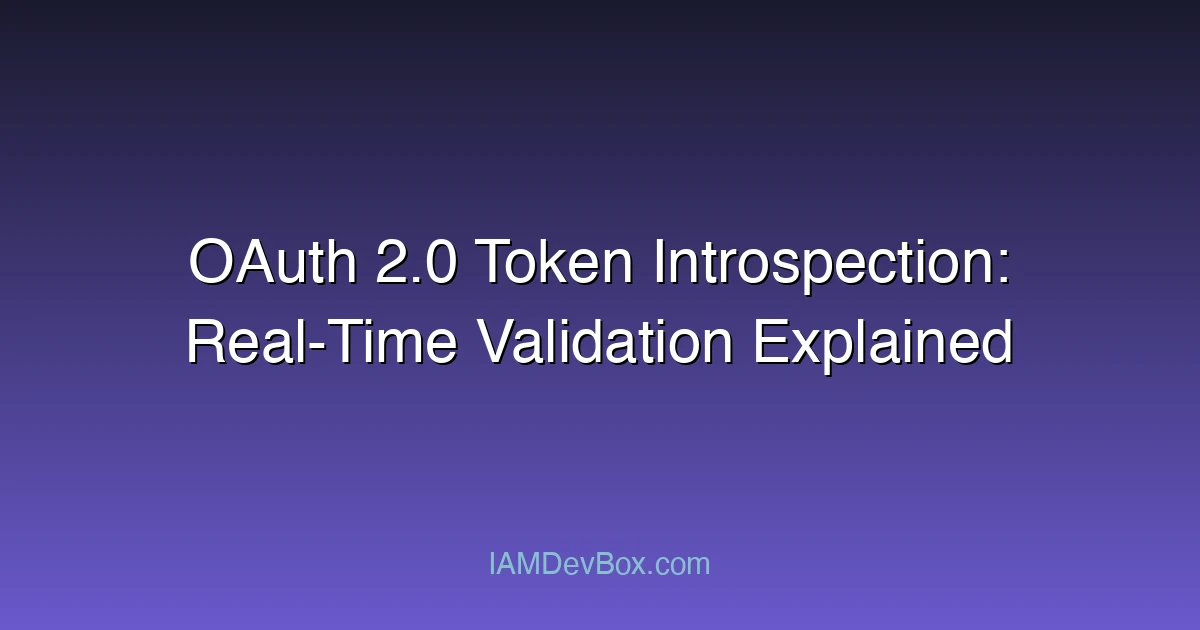Visual Overview:
graph LR
subgraph JWT Token
A[Header] --> B[Payload] --> C[Signature]
end
A --> D["{ alg: RS256, typ: JWT }"]
B --> E["{ sub, iss, exp, iat, ... }"]
C --> F["HMACSHA256(base64(header) + base64(payload), secret)"]
style A fill:#667eea,color:#fff
style B fill:#764ba2,color:#fff
style C fill:#f093fb,color:#fff
OAuth 2.0 Token Introspection is a mechanism that allows resource servers to query the authorization server to determine the active state and metadata of an access token in real-time. This is essential for validating tokens and enforcing fine-grained access control.
What Is Token Introspection?
Token introspection is defined in RFC 7662. It provides a standardized way for a resource server to ask the authorization server whether an access token is valid and to retrieve associated metadata such as scopes, expiration, and client info.
Why Token Introspection Matters
- Real-time token status: Ensures tokens are still active and not revoked or expired.
- Enforces token scope: Validates the permissions granted to the token holder.
- Supports opaque tokens: Unlike JWTs, opaque tokens have no embedded data, requiring introspection for validation.
- Improves security: Detects invalid or compromised tokens immediately.
How Token Introspection Works
The resource server sends a POST request to the introspection endpoint with the token to be validated.
Example cURL introspection request:
curl -X POST "https://auth.example.com/oauth2/introspect" \
-H "Content-Type: application/x-www-form-urlencoded" \
-d "token=ACCESS_TOKEN" \
-u "client_id:client_secret"
The response contains JSON data indicating whether the token is active and other details:
{
"active": true,
"scope": "read write",
"client_id": "client123",
"username": "[email protected]",
"exp": 1685894400,
"iat": 1685808000,
"token_type": "access_token"
}
active: Boolean indicating if token is valid.scope: Permissions granted.exp,iat: Expiration and issuance timestamps.username,client_id: Token owner info.
When to Use Token Introspection
- When using opaque access tokens that cannot be decoded locally.
- To enforce immediate revocation or session termination.
- When token metadata is needed for authorization decisions.
- For resource servers that require strong trust in token validation.
Token Introspection vs JWT Validation
- JWT: Self-contained token, validated locally by verifying signature and claims, no introspection required.
- Opaque tokens: Require introspection as token content is hidden.
Hybrid approaches use JWTs with short lifespan plus introspection for refresh tokens or enhanced security.
🎯 Key Takeaways
- Protect introspection endpoint with strong client authentication
- Use HTTPS for all introspection requests
- Limit data returned to only necessary fields to minimize information leakage
- Cache introspection responses carefully to balance performance and security
Security Best Practices
- Protect introspection endpoint with strong client authentication.
- Use HTTPS for all introspection requests.
- Limit data returned to only necessary fields to minimize information leakage.
- Cache introspection responses carefully to balance performance and security.
Real Case
A microservices architecture uses an API gateway that introspects incoming tokens to ensure only authorized calls pass through. If a token is revoked mid-session, introspection instantly blocks access.
Summary
Token introspection adds an important layer of real-time validation to OAuth 2.0 flows, especially when opaque tokens are used. It empowers resource servers to make informed access decisions, enhancing security and compliance.
👉 Related:
Understanding Token Revocation and When to Use It
How OAuth 2.0 Refresh Tokens Work: Best Practices and Expiry
💡 How does your system handle token validation for different token types? Do you rely on introspection, JWT validation, or a hybrid?
